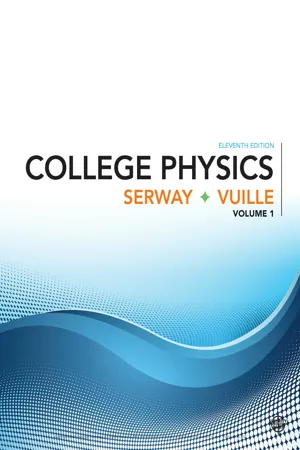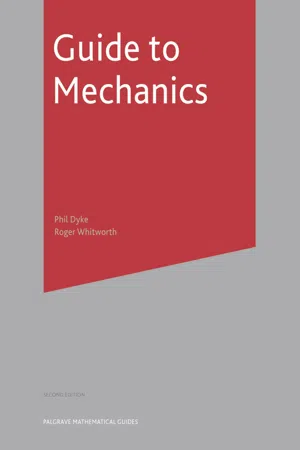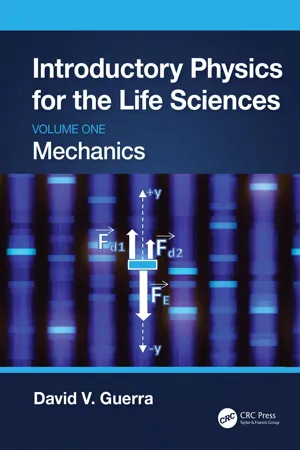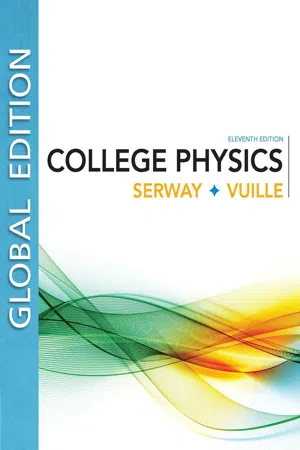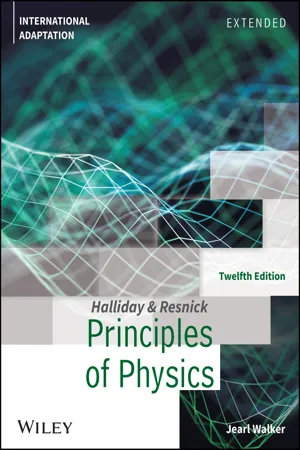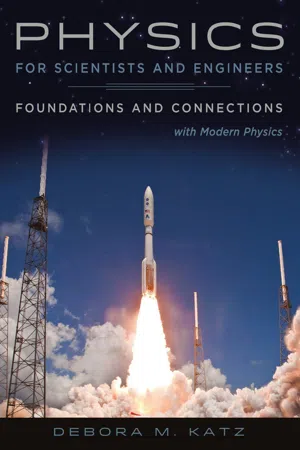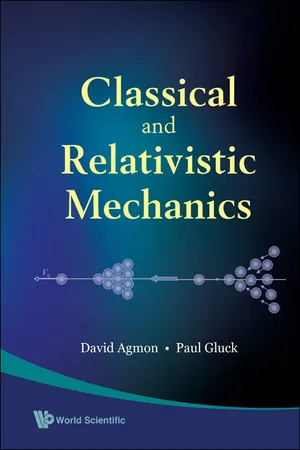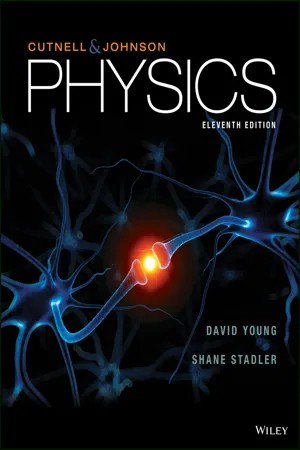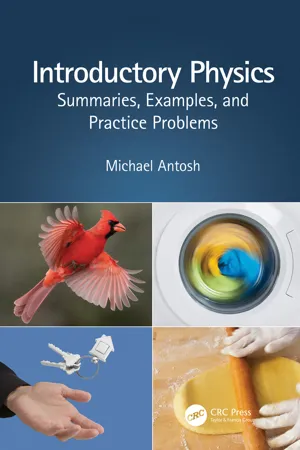Mathematics
Constant Acceleration
Constant acceleration refers to a situation where an object's velocity changes by the same amount in each equal time interval. In mathematical terms, it means that the rate of change of velocity with respect to time remains constant. This concept is often used in physics and engineering to analyze the motion of objects under the influence of a constant force.
Written by Perlego with AI-assistance
Related key terms
1 of 5
12 Key excerpts on "Constant Acceleration"
- eBook - PDF
- John D. Cutnell, Kenneth W. Johnson, David Young, Shane Stadler(Authors)
- 2021(Publication Date)
- Wiley(Publisher)
It equals the change ∆ → v in the velocity divided by the elapsed time ∆t, the change in the velocity being the final minus the initial velocity; see Equation 2.4. When ∆t becomes infinitesimally small, the average acceleration becomes equal to the instantaneous acceleration → a , as Focus on Concepts 51 indicated in Equation 2.5. Acceleration is the rate at which the veloc- ity is changing. ¯ → a = ∆ → v ___ ∆t (2.4) → a = lim Δt→0 ∆ → v ___ ∆t (2.5) 2.4 Equations of Kinematics for Constant Acceleration/ 2.5 Applications of the Equations of Kinematics The equa- tions of kinematics apply when an object moves with a Constant Acceleration along a straight line. These equations relate the dis- placement x − x 0 , the acceleration a, the final velocity υ, the initial velocity υ 0 , and the elapsed time t − t 0 . Assuming that x 0 = 0 m at t 0 = 0 s, the equations of kinematics are as shown in Equations 2.4 and 2.7–2.9. υ = υ 0 + at (2.4) x = 1 _ 2 (υ 0 + υ)t (2.7) x = υ 0 t + 1 _ 2 at 2 (2.8) υ 2 = υ 0 2 + 2ax (2.9) 2.6 Freely Falling Bodies In free-fall motion, an object experi- ences negligible air resistance and a Constant Acceleration due to grav- ity. All objects at the same location above the earth have the same acceleration due to gravity. The acceleration due to gravity is directed toward the center of the earth and has a magnitude of approximately 9.80 m/s 2 near the earth’s surface. 2.7 Graphical Analysis of Velocity and Acceleration The slope of a plot of position versus time for a moving object gives the object’s velocity. The slope of a plot of velocity versus time gives the object’s acceleration. Focus on Concepts Online Time Position A B C QUESTION 8 Section 2.6 Freely Falling Bodies 6. A rocket is sitting on the launch pad. The engines ignite, and the rocket begins to rise straight upward, picking up speed as it goes. At about 1000 m above the ground the engines shut down, but the rocket continues straight upward, losing speed as it goes. - Raymond Serway, John Jewett(Authors)
- 2018(Publication Date)
- Cengage Learning EMEA(Publisher)
The velocity at each instant is indicated by a red arrow, and the Constant Acceleration is indicated by a purple arrow. v v v a a This car moves at constant velocity (zero acceleration). This car has a Constant Acceleration in the direction of its velocity. This car has a Constant Acceleration in the direction opposite its velocity. a b c Copyright 2019 Cengage Learning. All Rights Reserved. May not be copied, scanned, or duplicated, in whole or in part. Due to electronic rights, some third party content may be suppressed from the eBook and/or eChapter(s). Editorial review has deemed that any suppressed content does not materially affect the overall learning experience. Cengage Learning reserves the right to remove additional content at any time if subsequent rights restrictions require it. 38 Chapter 2 Motion in One Dimension If we replace a x,avg by a x in Equation 2.9 and take t i 5 0 and t f to be any later time t , we find that a x 5 v xf 2 v xi t 2 0 or v xf 5 v xi 1 a x t (for constant a x ) (2.13) This powerful expression enables us to determine an object’s velocity at any time t if we know the object’s initial velocity v xi and its (constant) acceleration a x . A velocity–time graph for this constant-acceleration motion is shown in Figure 2.11b. The graph is a straight line, the slope of which is the acceleration a x ; the (con- stant) slope is consistent with a x 5 dv x / dt being a constant. Notice that the slope is positive, which indicates a positive acceleration. If the acceleration were negative, the slope of the line in Figure 2.11b would be negative. When the acceleration is constant, the graph of acceleration versus time (Fig. 2.11c) is a straight line having a slope of zero.- eBook - PDF
- Raymond Serway, Chris Vuille(Authors)
- 2017(Publication Date)
- Cengage Learning EMEA(Publisher)
All Rights Reserved. May not be copied, scanned, or duplicated, in whole or in part. WCN 02-200-202 2.3 | One-Dimensional Motion with Constant Acceleration 43 or v 5 v 0 1 at (for constant a) [2.6] Equation 2.6 states that the acceleration a steadily changes the initial velocity steadily changes the initial velocity v 0 by an amount at. For example, if a car starts with a velocity of 12.0 m/s to the right and accelerates to the right with a 5 16.0 m/s 2 , it will have a velocity of 114 m/s after 2.0 s have elapsed: v 5 v 0 1 at 5 1 2.0 m/s 1 (6.0 m/s 2 )(2.0 s) 5 114 m/s The graphical interpretation of v is shown in Figure 2.15b. The velocity varies is shown in Figure 2.15b. The velocity varies linearly with time according to Equation 2.6, as it should for Constant Acceleration. Because the velocity is increasing or decreasing uniformly with time, we can y with time, we can y express the average velocity in any time interval as the arithmetic average of the initial velocity v 0 and the final velocity v : v 5 v 0 0 1 v 2 (for constant a) [2.7] Remember that this expression is valid only when the acceleration is constant, in which case the velocity increases uniformly. We can now use this result along with the defining equation for average veloc- ity, Equation 2.2, to obtain an expression for the displacement of an object as a function of time. Again, we choose t i 5 0 and t f t f t f 5 t, and for convenience, we write Dx 5 x f x f x f 2 x i 5 x 2 x 0 . This results in Dx 5 v t 5 a v 0 0 1 v 2 b t Dx 5 1 2 1 v 0 0 1 v 2 t (for constant a) [2.8] We can obtain another useful expression for displacement by substituting the equation for v (Eq. 2.6) into Equation 2.8: (Eq. 2.6) into Equation 2.8: Dx 5 1 2 1 v 0 0 1 v 0 0 1 at 2 t D x 5 v 0 0 t 1 1 2 a t 2 (for constant a) [2.9] This equation can also be written in terms of the position x, since Dx 5 x 2 x 0 . - eBook - PDF
- Philip Dyke, Roger Whitworth(Authors)
- 2017(Publication Date)
- Red Globe Press(Publisher)
Again, using calculus notation gives: a d v d t d 2 x d t 2 Acceleration is derived from a vector so it must be a vector itself, possessing both magnitude and direction. Acceleration is the most difficult concept to appreciate intuitively. It can be non-zero when the speed of the body is constant but the direction of the motion varies. There are numerous examples of motion with constant speed but non-zero acceleration and some will be discussed in later chapters. In Figure 1.3, which illustrates the process of cornering with constant speed, the velocities of motion at points P and Q , which occur at a one-second interval, are given as v 1 and v 2 . Note that v 1 6 v 2 . Figure 1.3 also shows the vector triangle for v 2 v 1 . The triangle ABC formed is isosceles as j v 1 j j v 2 j . The acceleration over the one-second interval is v 2 v 1 , the direction BC represents the direction of this acceleration and the length BC is its magnitude, which is non-zero. Of course, the acceleration is not in the same direction as v 1 or v 2 . First we will look at the study of one-dimensional models of motion. It turns out that the understanding that comes from this study can then be easily interpreted in two and three dimensions using vector notation, with the algebra remaining unchanged. This is one big advantage of using vector notation in mechanics. There are others. Kinematics 3 1.3 One-dimensional models The special case of motion in a straight line is a usual starting point for the study of kinematics. Examples are the motion of a body falling vertically under gravity or that of a particle attached to a spring lying on a smooth horizontal table. Here we shall maintain a vector approach, but because we are largely con-cerned with one-dimensional problems, we can see that all quantities can be expressed as negative and positive values along the direction of motion, labelled the x -axis, and represented by the unit vector i . - David V. Guerra(Author)
- 2023(Publication Date)
- CRC Press(Publisher)
(7.3)The SI unit for acceleration is (m/s)/s, which is usually written m/s2 .For example, as shown in Figure 7.5 , if a car is traveling northward at 10 m/s and speeds up to 30 m/s northward in 5 seconds, the average acceleration during those 5 seconds is:= ( 30 m/s northward – 10 m/s northward ) / ( 5 seconds ) = 4a ⇀Avg01m/s 2northward .FIGURE 7.5 Example of Constant Acceleration.If, during the 5 seconds in which the car is speeding up, the car increases its speed (without changing the direction of its velocity) at a constant rate, the acceleration is said to be constant and the acceleration at any instant in time during those 5 seconds will be the same as the average acceleration.When a rigid body undergoes purely translational motion, every part of the body undergoes the same motion, but different parts move along different curves or lines. When studying the motion of a rigid body, to determine the motion of the object, it is common to track the motion of the rigid body’s center of mass.7.2.1 One-Dimensional Motion
For this and the next few chapters, the motion studied will be along a line in one-dimension. It is common to choose our x-y-z coordinate system so that the x-axis or y-axis is along the line in which the motion occurs. Then, the motion will only have one component of displacementvelocityd ⇀,and accelerationv ⇀,a ⇀, such as the x-components, dx , vx, ax , or the y-components, dy , vy, ay- eBook - PDF
- Raymond Serway, Chris Vuille(Authors)
- 2017(Publication Date)
- Cengage Learning EMEA(Publisher)
This type of motion is important because it applies to numerous objects in nature, such as an object in free fall near Earth’s surface (assuming air resistance can be neglected). A graph of acceleration versus time for motion with constant accelera- tion is shown in Figure 2.15a. When an object moves with Constant Acceleration, the instantaneous acceleration at any point in a time interval is equal to the value of the average acceleration over the entire time interval. Consequently, the velocity increases or decreases at the same rate throughout the motion, and a plot of v ver- sus t gives a straight line with either positive, zero, or negative slope. Because the average acceleration equals the instantaneous acceleration when a is constant, we can eliminate the bar used to denote average values from our defin- ing equation for acceleration, writing a 5 a, so that Equation 2.4 becomes a 5 v f 2 v i t f 2 t i The observer timing the motion is always at liberty to choose the initial time, so for convenience, let t i 5 0 and t f be any arbitrary time t. Also, let v i 5 v 0 (the initial velocity at t 5 0) and v f 5 v (the velocity at any arbitrary time t). With this notation, we can express the acceleration as a 5 v 2 v 0 t Figure 2.13 (Quick Quiz 2.4) Which position vs. time curve is impossible? x t x t x t a b c Figure 2.14 (Quick Quiz 2.5) Choose the correct graphs. t O + x + t O v – + t O a – a b c d Figure 2.15 A particle moving along the x-axis with Constant Acceleration a. (a) the acceleration vs. time graph, (b) the velocity vs. time graph, and (c) the position vs. time graph. v v t v 0 v 0 at t Slope = a x t x 0 Slope = v 0 t Slope = v t a t Slope = 0 a a b c Copyright 2018 Cengage Learning. All Rights Reserved. May not be copied, scanned, or duplicated, in whole or in part. WCN 02-300 - David Halliday, Robert Resnick, Jearl Walker(Authors)
- 2023(Publication Date)
- Wiley(Publisher)
(2.4.8) These are not valid when the acceleration is not constant. Free-Fall Acceleration An important example of straight- line motion with Constant Acceleration is that of an object rising or falling freely near Earth’s surface. The constant- acceleration equations describe this motion, but we make two changes in notation: (1) We refer the motion to the vertical y axis with +y vertically up; (2) we replace a with −g, where g is the magnitude of the free-fall acceleration. Near Earth’s surface, g = 9.8 m/s 2 (= 32 ft/s 2 ). 1 Figure 2.1 gives the velocity of a particle moving on an x axis. What are (a) the initial and (b) the final directions of travel? (c) Does the particle stop momentarily? (d) Is the acceleration positive or negative? (e) Is it constant or varying? 2 Figure 2.2 gives the accel- eration a(t) of a Chihuahua as it chases a German shepherd along an axis. In which of the time periods indicated does the Chihuahua move at constant speed? a A B C D E F G H t FIGURE 2.2 Question 2. 3 Figure 2.3 shows four paths along which objects move from a starting point to a final point, all in the same time interval. The paths pass over a grid of equally spaced straight lines. Rank the paths according to (a) the average velocity of the objects and (b) the average speed of the objects, great- est first. 4 Figure 2.4 is a graph of a particle’s position along an x axis versus time. (a) At time t = 0, what is the sign of the particle’s position? Is the particle’s velocity positive, negative, or 0 at (b) t = 1 s, (c) t = 2 s, and (d) t = 3 s? (e) How many times does the parti- cle go through the point x = 0? 5 Figure 2.5 gives the velocity of a particle moving along an axis. Point 1 is at the highest point on the curve; point 4 is at the low- est point; and points 2 and 6 are at the same height.- No longer available |Learn more
Physics for Scientists and Engineers
Foundations and Connections, Extended Version with Modern Physics
- Debora Katz(Author)
- 2016(Publication Date)
- Cengage Learning EMEA(Publisher)
Similar derivations can be done for any other axis. Velocity as a Function of Time for Constant Acceleration From Figure 2.24A, we know that the velocity-versus-time graph is linear in the special case of Constant Acceleration. The tangent at any point on the line coincides with the line itself. Therefore, in the case of Constant Acceleration a x , the average acceleration a av, x over any time interval and the instantaneous acceleration a x 1t 2 at all particular times are equal: a x 1t 2 5 a x 5 a av, x 5 v x 1t f 2 2 v x 1t i 2 t f 2 t i It is conventional practice to set the initial time to zero and replace t f with t . The initial velocity v x 10 2 is written v 0x , and the acceleration is a x 5 v x 1t 2 2 v 0x t Solve this equation for v x 1t 2 : v x 1t 2 5 v 0x 1 a x t (2.9) Equation 2.9 is the first of the five equations and gives velocity as a function of time for Constant Acceleration. Equation 2.9 is linear, in the form y 5 mx 1 b, de- scribing either of the lines in Figure 2.24A with a x equal to the slope (m) and v 0x equal to the y intercept (b). Displacement as a Function of Velocity and Time In Figure 2.21, we found the displacement from the area under a velocity-versus- time curve in the case of zero acceleration. When there is a nonzero acceleration, we can still find the displacement as the area under the curve. We can break this area into two shapes, the light blue triangle and the dark blue rectangle (Fig. 2.26). The sum of these two areas is the displacement in the time interval t, Dx 5 1 2 1v 0x 1 v x 2 t (2.10) Constant Acceleration ▲ Special Case Here, we use the symbol a x without (t) to indicate that the acceleration is a constant at all times. All content on this page is © Cengage Learning. FIGURE 2.26 Velocity-versus-time graph for the special case of constant accelera- tion. The area under the curve is the dis- placement in time t. - eBook - PDF
- David Agmon, Paul Gluck;;;(Authors)
- 2009(Publication Date)
- WSPC(Publisher)
For example, if a stone is thrown vertically upward, the direction of its velocity is opposite to that of its acceleration. For a body thrown horizontally the acceleration is perpendicular to the direction of the initial velocity. Example 4 Kinematic formulae for Constant Acceleration. At t = 0 a body is at a distance JC 0 from the origin and has velocity Vo along the x-axis. Its acceleration is constant and in the direction of motion. We assume for simplicity that xo, V 0 , a are all positive, though it makes no essential difference. Use the appropriate definitions to (a) find the velocity as a function time for t > 0, (b) find the position of the body as a function time for t >0. (c) Develop a formula relating the distance from the origin to the velocity. Solution Although the solution could be found by other means, we prefer to obtain it by integrating the equations for the acceleration and the velocity. We thereby acquire a powerful mathematical tool, which in addition enables us to tackle the case of variable acceleration. (a) To get the velocity-time relation we start from definition (2.5), dV = adt. We integrate this equation between 0 to t and between V 0 and V (the velocity at t). Using primed symbols for the integration variables we have dV'= adV => V -V 0 =at (since the acceleration is constant, it can be taken outside the integral), or V = V 0 +af (2.7) (b) To get the displacement-time relation we use (2.2) and (2.7) dx = V(t)dt = (V 0 + ai)dt 32 Classical and Relativistic Mechanics Integrating, with time limits as before, and for x between x 0 and x, we obtain X t * tdx'= UVQ+CHW => x-x 0 =V 0 t +—at 2 x = x 0 +V 0 t + at /2 (2.8) (c) The velocity-displacement relation is obtained by eliminating time from (2.7)-(2.8). Squaring (2.7) results in V 2 (t) = V 2 +2V 0 at + a 2 t 2 =V 2 +2a(V 0 t + at 2 /2) = V 2 +2a(x-x Q ) or V 2 (x) = V 2 +2a(x-x 0 ) (2.9) ait) -+t Acceleration vs. - eBook - ePub
- John D. Cutnell, Kenneth W. Johnson, David Young, Shane Stadler(Authors)
- 2018(Publication Date)
- Wiley(Publisher)
Equation 2.3 .(2.1)Average speed =(2.2)Distance Elapsed time(2.3)=v →‾Δx →Δ tv →=limΔ t → 0Δx →Δ t- 2.3 Acceleration The average acceleration
is a vector. It equals the changea →‾Δin the velocity divided by the elapsed timev →Δt, the change in the velocity being the final minus the initial velocity; see Equation 2.4 . WhenΔtbecomes infinitesimally small, the average acceleration becomes equal to the instantaneous accelerationa →, as indicated in Equation 2.5 . Acceleration is the rate at which the velocity is changing. (2.4)(2.5)=a →‾Δv →Δ ta →=limΔ t → 0Δv →Δ t- 2.4
Equations of Kinematics for Constant Acceleration/2.5 Applications of the Equations of KinematicsThe equations of kinematics apply when an object moves with a Constant Acceleration along a straight line. These equations relate the displacementx − x0, the acceleration a, the final velocity v, the initial velocity v0 , and the elapsed timet − t0. Assuming thatx0 = 0 matt0 = 0 s, the equations of kinematics are as shown in Equations 2.4 and 2.7–2.9. (2.4)v =(2.7)v 0+ a tx =(2.8)1 2(t)v 0+ vx =(2.9)v 0t =1 2at 2v 2=v 0 2+ 2 a x- 2.6 Freely Falling Bodies In free-fall motion, an object experiences negligible air resistance and a Constant Acceleration due to gravity. All objects at the same location above the earth have the same acceleration due to gravity. The acceleration due to gravity is directed toward the center of the earth and has a magnitude of approximately
9.80 m/s2near the earth's surface.- 2.7 Graphical Analysis of Velocity and Acceleration
- eBook - ePub
Doing Physics with Scientific Notebook
A Problem Solving Approach
- Joseph Gallant(Author)
- 2012(Publication Date)
- Wiley(Publisher)
If the displacement and velocity have the same sign, the object is moving away from the origin. If they have opposite signs, the object is moving toward the origin.Table 2.2 summarizes the sign information for velocity and acceleration for horizontal motion.Table 2.2
If the velocity and the acceleration have the same sign, the object’s speed is increasing. If they have opposite signs, the object is slowing down. For vertical motion, just replace the word “right” with “up” and replace the word “left” with “down” in both tables.Velocity Acceleration Interpretation Positive Positive Moving right, speed increasing Positive Negative Moving right, speed decreasing Negative Positive Moving left, speed decreasing Negative Negative Moving left, speed increasing Free Fall
One famous and important example of Constant Acceleration motion is the motion of an object under the influence of gravity near the Earth’s surface. This vertical acceleration is a = - g where g = 9.8067 m/ s2 is the acceleration’s magnitude and the minus sign indicates gravity acts down. Because the acceleration due to gravity is approximately constant, all objects fall at the same constant rate.When gravity is the only force acting on an object, we say it is in free fall. As long as the object is not too light or moving too fast, air resistance is negligible and gravity determines its motion. An object is in free fall as soon as it is released, whether it is dropped or thrown, whether it is going up or down.We can apply Eqs. (2.5) to this problem. To distinguish horizontal motion from vertical, let’s rewrite the equations of motion letting y denote vertical position (height). When you change x → y and let a = - g, you have the following four equations.(2.6a)(2.6b)(2.6c)(2.6d)These four equations describe the motion of an object that is dropped or thrown straight up or down under the influence of gravity with negligible air resistance. They relate the object’s height and vertical velocity to the acceleration due to gravity and the time, with up as positive and down as negative. - eBook - ePub
Introductory Physics
Summaries, Examples, and Practice Problems
- Michael Antosh(Author)
- 2023(Publication Date)
- CRC Press(Publisher)
Side note: these equations (from Section 2.6) don’t include position by itself (just displacement), and they don’t have average velocity or average acceleration. Instead, they contain quantities that you see much more regularly in your everyday life – velocities at some specific time (instantaneous), how far you moved, etc. Be careful – it’s very common for students to get confused and use the equations for average velocity and average acceleration instead of the equations in this section. Usually, you only want to use the equations for average velocity and average acceleration if the word “average” is specifically mentioned in the problem.Example 2.6.1: The Short Yellow Traffic Light (Linear Motion with Constant Acceleration)You’re driving with a velocity of 20.0 m/s. Suddenly, a traffic light in front of you turns yellow. You quickly put on the brakes and slide to a stop. Assume that the acceleration is constant. It takes you 3.00 seconds to stop after you start to hit the brakes.- How far do you travel along the road during the 3.00-second braking time?
- What is the acceleration (magnitude and direction) of the car during those 3.00 seconds?
Solution:Part A:Since the acceleration is constant, we can use Equations 2.6.1–2.6.4 above. We first need to set a coordinate system and determine the initial and final time points. When something is moving in a straight line, it’s usually easiest to define the direction it is moving in as positive. Let’s make the initial time point to be the time when braking starts, and the final time point to be when the car reaches zero velocity (a stop).What variables do we know?- vi = 20.0 m/s (positive)
- Δt = 3.00 s (time between initial and final time points)
- vf = 0 (the car comes to a stop at the final time point)
Let’s solve for Δx first – it’s Part A. Looking at Equations 2.6.1–2.6.4, we need an equation that has Δx as well as the variables we know (vi , Δt, and vf
Index pages curate the most relevant extracts from our library of academic textbooks. They’ve been created using an in-house natural language model (NLM), each adding context and meaning to key research topics.


